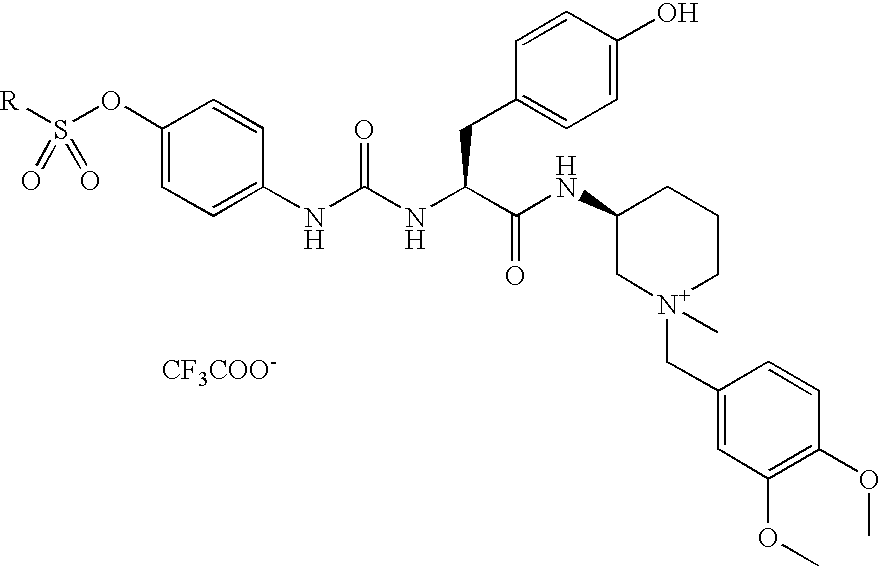Novel m3 muscarinic acetylcholine receptor antagonists
a technology of muscarinic acetylcholine and receptors, which is applied in the direction of biocide, drug composition, immunological disorders, etc., can solve the problems of anti-muscarinic compounds in us
- Summary
- Abstract
- Description
- Claims
- Application Information
AI Technical Summary
Problems solved by technology
Method used
Image
Examples
preparation 1
[0097] Resin-bound amines 3 were prepared by reductive alkylation of 2,6-dimethoxy-4-polystyrenebenzyloxy-benzaldehyde (DMHB resin) with N-protected diamine HCl salts 2, which were prepared from Boc-protected diamines 1 (Scheme 1). Reactions of 3 with Fmoc-protected amino acids, followed by removal of the protecting group, provided resin-bound intermediates 4. 4-Hydroxyl anline was coupled with resin-bound intermediates 4 to afford the corresponding resin-bound urea 5, which was subsequently treated with potassium carbonate and thiophenol to give secondary amines. Reductive amination of secondary amine with aldehydes produced resin-bound tertiary amines 6. Amines 6 were then reacted with a series of sulfonyl chlorides to give the corresponding resin-bound sulfonyl esters 7, which were treated with alkyl halides(R4Z) to give the corresponding resin-bound quaternary ammonium salts. Resin-bound quaternary ammonium salts were cleaved with 50% trifluoroacetic acid in dichloromethane to a...
example 1
Preparation of N-((3S)-1-{[3,4-bis(methyloxy)phenyl]methyl}-1-methyl-3-piperidiniumyl)-N-{[(4-{[(2,5-dimethyl-3-thienyl)sulfonyl]oxy}phenyl)amino]carbonyl}-L-tyrosinamide Trifluoroacetate
a) 3(S)-amino-N-(2-nitrobenzenesulfonyl)pyrrolidine HCl Salt
[0099] To a solution of 3(S)-(−)-(tert-butoxycarbonyl-amino)pyrrolidine (20.12 g, 108 mmol) in 250 mL of anhydrous methylene chloride at 0° C. was added 13.1 mL (162 mmol) of anhydrous pyridine, followed by slow addition of 25.2 g (113.4 mmol) of 2-nitrobenzenesulfonyl chloride. The mixture was warmed to rt over 1 h and stirred at rt for 16 h. The mixture was poured into 300 mL of 1 M aqueous NaHCO3 solution. After the resulting mixture was stirred at rt for 30 min, the organic layer was separated and washed with 500 mL of 1N aqueous HCl solution twice. The resulting organic layer was dried over MgSO4 and concentrated in vacuo. The residue was used for the the next step without further purification.
[0100] To a mixture of the above resid...
preparation 2
[0115] 4-Nitrobenzene sulfonyl chloride reacted with isopropyl amine to provide the isopropyl sulfonyl amide 9. The nitro group in 9 was converted to amine 10 via SnCl2. The amine was coupled with resin-bound amines 4 to afford the corresponding resin-bound ureas 11. The urea was subsequently treated with benzenethiolate to give secondary amine, which underwent reductive amination with appropriate aldehydes to produce tertiary amine 12. Amine 12 was then treated with alkyl halides to form the corresponding resin-bound quaternary ammonium salts, which were cleaved with 50% trifluoroacetic acid in dichloromethane to afford targeted compounds 13.
Conditions: a) Toluene 80° C. b) SnCl2, EtOH, 70° C.; c) 4-nitrobenzene chloroformate, tetrahydrofuran, diisopropylethylamine, dimethyl formamide, rt; d) K2CO3, PhSH, 1-methyl-2-pyrrolidinone, rt; e) R2CHO, Na(OAc)3BH, 10% acetic acid in 1-methyl-2-pyrrolidinone, rt; f) R4Z, acetonitrile, rt; g) 50% trifluoroacetic acid in dichloromethane, r...
PUM
| Property | Measurement | Unit |
|---|---|---|
| temperature | aaaaa | aaaaa |
| volume | aaaaa | aaaaa |
| volume | aaaaa | aaaaa |
Abstract
Description
Claims
Application Information
 Login to View More
Login to View More - R&D
- Intellectual Property
- Life Sciences
- Materials
- Tech Scout
- Unparalleled Data Quality
- Higher Quality Content
- 60% Fewer Hallucinations
Browse by: Latest US Patents, China's latest patents, Technical Efficacy Thesaurus, Application Domain, Technology Topic, Popular Technical Reports.
© 2025 PatSnap. All rights reserved.Legal|Privacy policy|Modern Slavery Act Transparency Statement|Sitemap|About US| Contact US: help@patsnap.com



